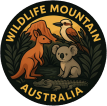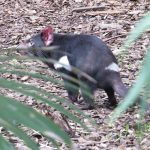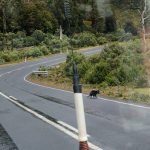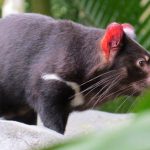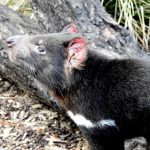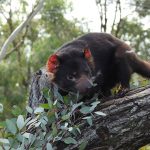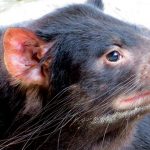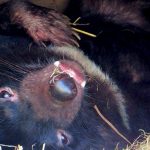Tasmanian devil
Nighttime Guardian of Tasmania
Journey with me into the shadowed forests of Tasmania, where the air is thick with the scent of eucalyptus, and the earth is cool and damp beneath towering ferns. Here, as dusk settles and the world quietens, a unique creature emerges into the night—the Tasmanian Devil.
Portrait of a Devil
Imagine a stocky animal, muscular and low to the ground, covered in jet-black fur that sometimes flashes a white streak across its chest or rump. Its head is broad with ears tinged red when excited, and its eyes glint with intelligence. The Tasmanian Devil’s sharp, curved teeth and powerful jaws set it apart—tools essential for its survival as both hunter and relentless scavenger.
Sensory Snapshot
- Sight & Sound: Devils are most active after dark, their eyes well-adapted to the low light. Echoes of their famed, raucous screeches pierce the night—a sound both thrilling and uncanny, reverberating through the silent bush.
- Touch & Smell: Their coarse fur bristles as they move through dense undergrowth, noses lifted, always searching for the rich smell of decaying carrion or the musky scent of a fellow Devil.
Wild Table: Tasmanian Devil Overview
| Feature | Description |
|---|---|
| Habitat | Forest, scrubland, coastal heath in Tasmania |
| Diet | Carrion, small mammals, birds, reptiles, insects |
| Behaviour | Nocturnal, solitary, highly vocal |
| Conservation | Endangered, threatened by DFTD |
Life and Survival
A Feast of Bones
Tasmanian Devils are nature’s ultimate recyclers, feeding on almost every part of a carcass, right down to the bone. Their jaw strength, disproportionate to their size, allows them to crush even the toughest bones—an ability rare among mammals. Picture a feasting Devil: jaws crunching, fur slicked with the scent of the wild, eager to leave nothing to waste.
Family in the Pouch
Each year, a female gives birth to as many as 20 to 30 tiny, undeveloped joeys—each no larger than a grain of rice. A race for survival unfolds as these newborns scramble to attach to one of only four teats in their mother’s pouch. Only the strongest survive, nestled safely as they continue to grow.
Voices in the Darkness
Despite their reputation, Tasmanian Devils are not aggressive towards humans. When threatened, however, they display a dramatic array of defensive behaviours—loud screeches, snarling growls, lunges, and bare-teethed displays. These performances, while fearsome, are mostly bluster—a way to avoid actual conflict.
Conservation: A Struggle for Survival
The Tasmanian Devil faces one of the most significant wildlife crises of the modern era. The spread of Devil Facial Tumour Disease (DFTD), a contagious cancer, has devastated populations, especially in eastern and northern Tasmania.
Conservation Efforts:
- Creation of disease-free sanctuaries
- Breeding programs and genetic diversity management
- Research into disease resistance and cures
Through the committed efforts of scientists, rangers, and local communities, the hope endures that the wild screams of the Devil will continue to echo through Tasmania’s forests for generations.
Emotional Connection
The tale of the Tasmanian Devil is not just one of peculiar adaptation but of resilience and vulnerability. In their fierce cries and nightly wanderings lies a reminder of the fragility and wonder of our natural world—a call for us all to cherish and protect these remarkable creatures, ensuring their shadows and voices remain a part of Tasmania’s living tapestry.
Did You Know?
- Ancient Survivors: Fossils show Tasmanian Devils once roamed mainland Australia, but today, they survive only in Tasmania.
- Ecological Role: By consuming carrion, Devils help keep Tasmania’s environment clean and disease-free.
- World’s Largest Carnivorous Marsupial: Since the extinction of the Thylacine, the Tasmanian Devil holds this unique title.
From their eerie nocturnal cries to their powerful jawbones, Tasmanian Devils hold a vital place in the story of Australia’s wildlife. With ongoing research, conservation, and public support, we can help ensure their place in the wild endures—reminding us all that every living thing, no matter how small or misunderstood, has a story worth saving.
Photo Gallery
Tasmanian devil eating by Sharon McGrigor
Tasmanian Devil resting by Sharon McGrigor
